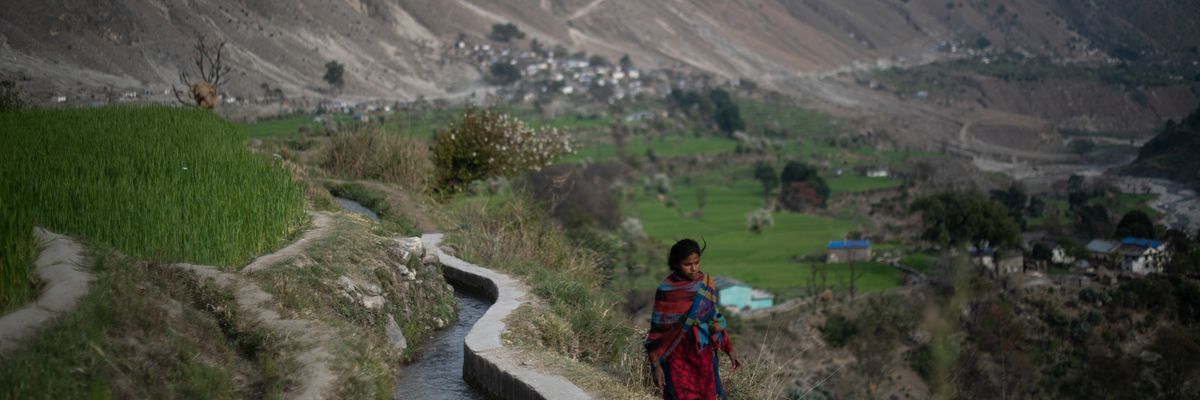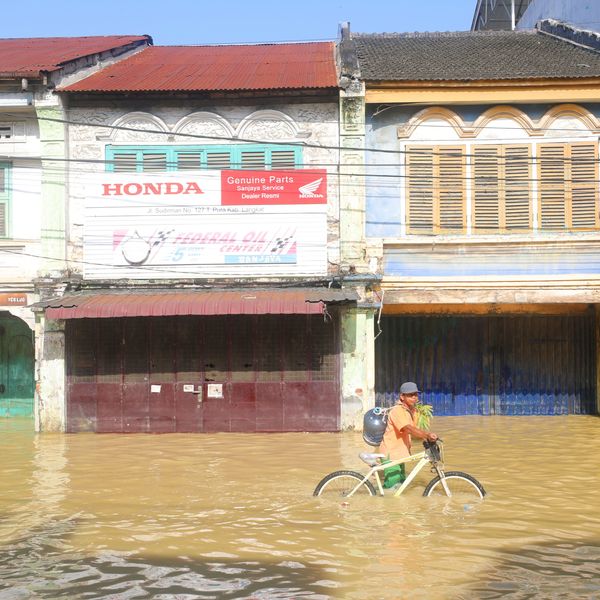
A Nepali child walks along an irrigation channel in Kolti town in the district of Bajura in Nepal on March 6, 2022.
'Alarming' Report Shows Billions at Risk From Historically Low Snow Melt in Himalayas
"The steadily declining persistence of seasonal snow is a warning bell for an emerging water crisis," according to the report.
A report released Monday found that snow persistence in the Hindu Kush Himalaya region, sometimes called the "third pole" because of its water resources, was at its lowest level in 23 years during the 2024-2025 winter, or 23.6% below normal—a concerning water security development for nearly two billion people who rely on river basins that are fed by the region's snowmelt.
All told, snowmelt from the Hindu Kush Himalaya (HKH) region contributes about a fourth of the total runoff of twelve major river basins in the region, on average. Snow persistence has been below normal across all twelve major river basins, per the report.
These findings come from the Hindu Kush Himalaya Snow Update, an annual report put out by the International Center for Integrated Mountain Development (ICIMOD), which provides yearly analysis of snow persistence in the region—the snow that usually stays on the ground between November and March.
"The steadily declining persistence of seasonal snow is a warning bell for an emerging water crisis," according to the author of the report. "Continuous deficit of meltwater from snow would mean lesser river runoff in dry months and early melt season, highlighting the urgent need for adaptive water resource management strategies in mitigating forthcoming impacts of water shortage, especially for downstream communities facing intensifying summer extremes."
The HKH region stretches multiple thousands of miles long across eight countries—Afghanistan, Bangladesh, Bhutan, China, India, Nepal, Myanmar and Pakistan—according GRID-Arendal, an environmental nonprofit based in Norway that works closely with the United Nations. It is the biggest volume of ice and snow outside of the Arctic and Antartica.
"While below-normal snow persistence has occurred before in this region—between 2003 and 2025 the region experienced thirteen below-normal snow years—the increasing frequency and intensity of such occurrences in recent times is a growing concern," according to the report. The 2024-2025 winter was the third consecutive year of below-normal snow persistence.
Sher Muhammad, a remote sensing specialist at ICIMOD who was the lead expert for the report, said in a statement published Monday that the deficit situations occurring in continuous succession is an "alarming trend."
ICIMOD's director general Pema Gyamtsho highlighted the need for policy solutions to address the problem over the long term in a statement published on Monday. "Carbon emissions have already locked in an irreversible course of recurrent snow anomalies in the HKH," said Gyamtsho.
Rising temperatures and water scarcity in the region has already created climate refugees.
Research from ICIMOD published in 2023 found that glaciers in the HKH region are melting at an accelerated rate and could lose up to 80% of their volume by century's end absent ambitious action to slash planet-warming emissions.
In March, a United Nations agency found that, worldwide, 2022-2024 saw the largest three-year loss of glaciers on record.
An Urgent Message From Our Co-Founder
Dear Common Dreams reader, The U.S. is on a fast track to authoritarianism like nothing I've ever seen. Meanwhile, corporate news outlets are utterly capitulating to Trump, twisting their coverage to avoid drawing his ire while lining up to stuff cash in his pockets. That's why I believe that Common Dreams is doing the best and most consequential reporting that we've ever done. Our small but mighty team is a progressive reporting powerhouse, covering the news every day that the corporate media never will. Our mission has always been simple: To inform. To inspire. And to ignite change for the common good. Now here's the key piece that I want all our readers to understand: None of this would be possible without your financial support. That's not just some fundraising cliche. It's the absolute and literal truth. We don't accept corporate advertising and never will. We don't have a paywall because we don't think people should be blocked from critical news based on their ability to pay. Everything we do is funded by the donations of readers like you. Will you donate now to help power the nonprofit, independent reporting of Common Dreams? Thank you for being a vital member of our community. Together, we can keep independent journalism alive when it’s needed most. - Craig Brown, Co-founder |
A report released Monday found that snow persistence in the Hindu Kush Himalaya region, sometimes called the "third pole" because of its water resources, was at its lowest level in 23 years during the 2024-2025 winter, or 23.6% below normal—a concerning water security development for nearly two billion people who rely on river basins that are fed by the region's snowmelt.
All told, snowmelt from the Hindu Kush Himalaya (HKH) region contributes about a fourth of the total runoff of twelve major river basins in the region, on average. Snow persistence has been below normal across all twelve major river basins, per the report.
These findings come from the Hindu Kush Himalaya Snow Update, an annual report put out by the International Center for Integrated Mountain Development (ICIMOD), which provides yearly analysis of snow persistence in the region—the snow that usually stays on the ground between November and March.
"The steadily declining persistence of seasonal snow is a warning bell for an emerging water crisis," according to the author of the report. "Continuous deficit of meltwater from snow would mean lesser river runoff in dry months and early melt season, highlighting the urgent need for adaptive water resource management strategies in mitigating forthcoming impacts of water shortage, especially for downstream communities facing intensifying summer extremes."
The HKH region stretches multiple thousands of miles long across eight countries—Afghanistan, Bangladesh, Bhutan, China, India, Nepal, Myanmar and Pakistan—according GRID-Arendal, an environmental nonprofit based in Norway that works closely with the United Nations. It is the biggest volume of ice and snow outside of the Arctic and Antartica.
"While below-normal snow persistence has occurred before in this region—between 2003 and 2025 the region experienced thirteen below-normal snow years—the increasing frequency and intensity of such occurrences in recent times is a growing concern," according to the report. The 2024-2025 winter was the third consecutive year of below-normal snow persistence.
Sher Muhammad, a remote sensing specialist at ICIMOD who was the lead expert for the report, said in a statement published Monday that the deficit situations occurring in continuous succession is an "alarming trend."
ICIMOD's director general Pema Gyamtsho highlighted the need for policy solutions to address the problem over the long term in a statement published on Monday. "Carbon emissions have already locked in an irreversible course of recurrent snow anomalies in the HKH," said Gyamtsho.
Rising temperatures and water scarcity in the region has already created climate refugees.
Research from ICIMOD published in 2023 found that glaciers in the HKH region are melting at an accelerated rate and could lose up to 80% of their volume by century's end absent ambitious action to slash planet-warming emissions.
In March, a United Nations agency found that, worldwide, 2022-2024 saw the largest three-year loss of glaciers on record.
A report released Monday found that snow persistence in the Hindu Kush Himalaya region, sometimes called the "third pole" because of its water resources, was at its lowest level in 23 years during the 2024-2025 winter, or 23.6% below normal—a concerning water security development for nearly two billion people who rely on river basins that are fed by the region's snowmelt.
All told, snowmelt from the Hindu Kush Himalaya (HKH) region contributes about a fourth of the total runoff of twelve major river basins in the region, on average. Snow persistence has been below normal across all twelve major river basins, per the report.
These findings come from the Hindu Kush Himalaya Snow Update, an annual report put out by the International Center for Integrated Mountain Development (ICIMOD), which provides yearly analysis of snow persistence in the region—the snow that usually stays on the ground between November and March.
"The steadily declining persistence of seasonal snow is a warning bell for an emerging water crisis," according to the author of the report. "Continuous deficit of meltwater from snow would mean lesser river runoff in dry months and early melt season, highlighting the urgent need for adaptive water resource management strategies in mitigating forthcoming impacts of water shortage, especially for downstream communities facing intensifying summer extremes."
The HKH region stretches multiple thousands of miles long across eight countries—Afghanistan, Bangladesh, Bhutan, China, India, Nepal, Myanmar and Pakistan—according GRID-Arendal, an environmental nonprofit based in Norway that works closely with the United Nations. It is the biggest volume of ice and snow outside of the Arctic and Antartica.
"While below-normal snow persistence has occurred before in this region—between 2003 and 2025 the region experienced thirteen below-normal snow years—the increasing frequency and intensity of such occurrences in recent times is a growing concern," according to the report. The 2024-2025 winter was the third consecutive year of below-normal snow persistence.
Sher Muhammad, a remote sensing specialist at ICIMOD who was the lead expert for the report, said in a statement published Monday that the deficit situations occurring in continuous succession is an "alarming trend."
ICIMOD's director general Pema Gyamtsho highlighted the need for policy solutions to address the problem over the long term in a statement published on Monday. "Carbon emissions have already locked in an irreversible course of recurrent snow anomalies in the HKH," said Gyamtsho.
Rising temperatures and water scarcity in the region has already created climate refugees.
Research from ICIMOD published in 2023 found that glaciers in the HKH region are melting at an accelerated rate and could lose up to 80% of their volume by century's end absent ambitious action to slash planet-warming emissions.
In March, a United Nations agency found that, worldwide, 2022-2024 saw the largest three-year loss of glaciers on record.

